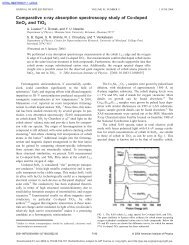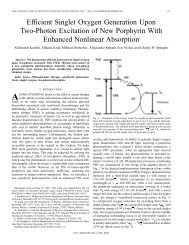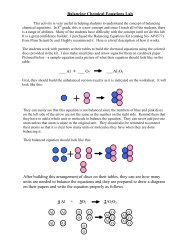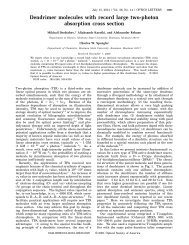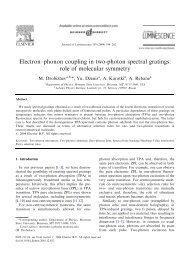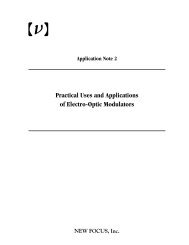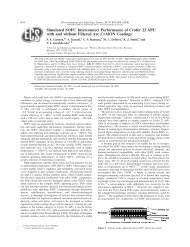Defects in inorganic photorefractive materials and their investigations
Defects in inorganic photorefractive materials and their investigations
Defects in inorganic photorefractive materials and their investigations
You also want an ePaper? Increase the reach of your titles
YUMPU automatically turns print PDFs into web optimized ePapers that Google loves.
22 B. Briat et al.<br />
Extr<strong>in</strong>sic defects:<br />
Cr 2+ [96], Cr 3+ [110], Cr 5+ [111, 112],<br />
Mn 2+ [113], Mn 4+ [114],<br />
Fe 2+ [115], Fe 3+ [116, 112], Fe 4+ [108], Fe 5+ [117, 108], Fe 3+ -V O [117], Fe 4+ -V O<br />
[112],<br />
Co 2+ [118], Co 3+ -V O [112], Co 4+ -V O [112],<br />
Ni + Ba [119],<br />
Mo 5+ [120],<br />
Rh 2+ [112], Rh 3+ [108], Rh 4+ ,Rh 5+ [108]<br />
Ir 4+ [112],<br />
Nd 3+ [121],<br />
Gd 3+ [122],<br />
Er 3+ [25],<br />
Ce 3+ [123],<br />
Na + Ba -O− [124], K + Ba -O− [124], Al 3+ -O − [112]<br />
Intr<strong>in</strong>sic defects:<br />
Ti 3+ (bound to various unidentified defects [125] or free as a conduction b<strong>and</strong><br />
polaron [10]), Ti 3+ -Nb 5+ [112]<br />
Table 3. <strong>Defects</strong> identified <strong>in</strong> BaTiO 3. The underl<strong>in</strong>ed charge states are EPR-silent.<br />
Their presence was proved <strong>in</strong>directly by comb<strong>in</strong>ed EPR/optical absorption studies.<br />
Especially <strong>in</strong> these cases the related optical absorption b<strong>and</strong>s <strong>and</strong> the charge transfer<br />
processes, <strong>in</strong> which these defects are <strong>in</strong>volved, have been determ<strong>in</strong>ed.<br />
temperatures. By dop<strong>in</strong>g with the shallow alkali acceptors, such as Na Ba ,<strong>and</strong><br />
additional oxidation [107], the Fermi-level can be lowered.<br />
Table 3 represents a large toolbox of defects whose possible <strong>in</strong>fluence on<br />
the <strong>photorefractive</strong> performance can be assessed on a microscopic basis. In<br />
this context the dop<strong>in</strong>gs Co <strong>and</strong> Ce , <strong>in</strong> addition to Rh, have received high<br />
attention. With Co-doped BaTiO 3 , hav<strong>in</strong>g a wide absorption b<strong>and</strong> at 2.25 eV,<br />
larger two- beam coupl<strong>in</strong>g ga<strong>in</strong>s were observed, us<strong>in</strong>g 515 nm light, than with<br />
Fe, Cr, or Mn dop<strong>in</strong>g [128]. The presence of Co 3+ -V O <strong>and</strong> of Co 2+ was<br />
identified <strong>in</strong> the crystals used <strong>in</strong> this <strong>in</strong>vestigation. The Ce 3+/4+ level lies near<br />
midgap <strong>and</strong> holes trapped there thus have a rather long lifetime [123, 129].<br />
Together with codoped Rh, <strong>in</strong>troduc<strong>in</strong>g a Rh 3+/4+ level more shallow than<br />
Ce 3+/4+ , the material offers potential for nonvolatile holographic storage by<br />
us<strong>in</strong>g gated two-wave illum<strong>in</strong>ation [123].<br />
5.2 Ba 1−x Ca x TiO 3 (BCT)<br />
The major drawback of BaTiO 3 for its application as a <strong>photorefractive</strong> material<br />
is the fact, that its phase transition from the tetragonal to the orthorhombic<br />
phase near 8 ◦ C tends to deteriorate the optical quality of the crystals.<br />
The replacement of part of Ba by Ca forms the isostructural Ba 1−x Ca x TiO 3





